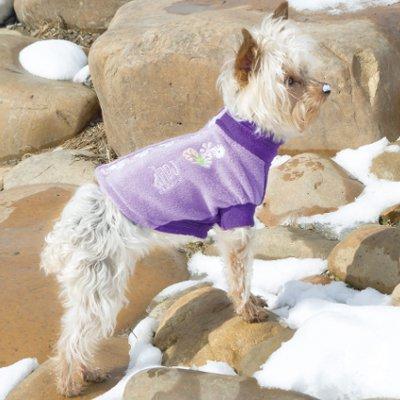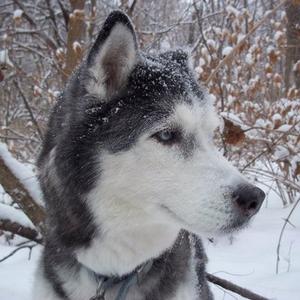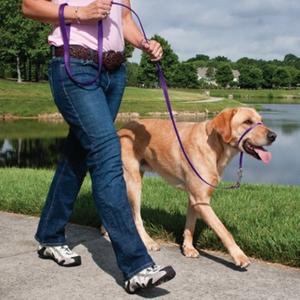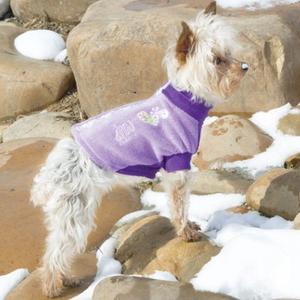By Susan Hoffman for Exceptional Canine

Last night’s snowstorm transformed your backyard into a winter wonderland, and you and your best friend can’t wait to get out there and play in the white stuff. Most canines can’t resist rolling in fresh snow and refereeing a good snowball fight. But you need to be the parent when it comes to your dog’s snow play. Just like a kid, your dog might not know when it’s time to come in from the cold. And it’s up to you to manage the snowballs that form on your dog’s coat.
Ice Is Not Nice

Ice clusters are the bane of medium- to long-haired dog owners. Not only do these frozen orbs make a mess in your house as they melt, the hard balls that form between your dog’s toes can feel like rocks under his feet, making him very uncomfortable.
So what’s the best way to cope with your abominable snowdog? “Use a warm, moist towel to help melt the balls and then use a dry towel, or even a hair dryer, if your dog will let you, to warm and dry your dog’s coat,” says Anne-Marie Forde, owner of The Sudsy Dog, Inc., an award-winning grooming facility in Erdenheim, Penn. “Many dogs with ‘advanced self-help skills' will try to pull the ice balls out themselves using their teeth. Before you let your dog do that, be sure he didn’t play anywhere where he could have come in contact with de-icer chemicals.”
Be gentle as you remove ice balls, cautions Dr. Jeffrey Berman, co-owner of Fort Washington Veterinary Hospital in Fort Washington, Penn. “You shouldn’t try to pull the ice balls out of your dog’s fur, because it can cause pain and some dogs will nip in defense,” says Berman. “Instead of tugging away, I recommend you speed up the melting process using a washcloth soaked in warm water and lightly massage the ice away. Pay particular attention to paws and pads and check them for lacerations.”
Ice Prevention Strategies
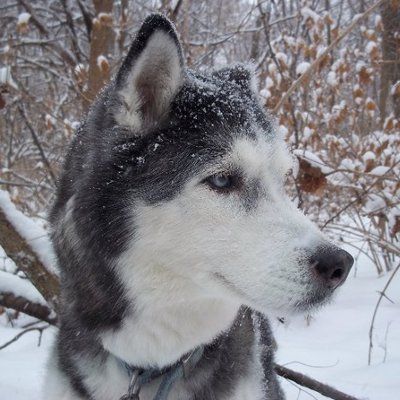
Although there are several techniques to get rid of ice matted into fur, preventing ice from forming in the first place is a good strategy. Before venturing into the snow:
- Apply petroleum jelly between the toes and on pads.
- Use products specifically made to protect dog feet, such as Musher’s Secret paw wax. You can find a dealer at www.musherssecret.net.
- Use clippers (not scissors) to trim excess fur on medium- to long-haired dogs (e.g., Poodles, Portuguese Water Dogs, Salukis). Pay particular attention to fur between the toes.
- Periodically brush snow off your dog’s fur while playing to prevent the formation of ice balls.
Have Fun, Play Safe
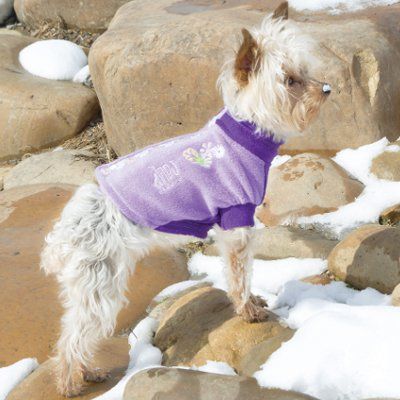
You and your buddy enjoy playing in the snow, but you also need to keep safety in mind. Consider these potential risks:
- Running in deep snow is hard work -- especially for small breeds or overweight dogs, which can lead to exhaustion or heart failure in a dog that has heart disease.
- Although you might be snug as a bug in your “Michelin Man” attire, remember that damp air and cold snow can be painful for a dog with arthritis.
- Extreme cold poses a frostbite threat to your dog’s nose and ears.
- “Ice is more dangerous than snow, because a dog slipping on an icy surface can rupture a cruciate ligament or hyperextend and sprain a limb,” says Berman.
While any dog worth his salt wants to investigate his frozen terrain, pay attention to your pet’s explorations. Some antifreeze products are deadly if ingested, and road salts can irritate his sensitive skin. Most dogs love snow, but if your pet starts to shiver from the cold, tires or is hesitant to continue playing, or if you notice the conditions are too icy, it’s time to call it quits and huddle by the fire indoors. Photo: @iStockphoto.com/RCerruti
Susan Hoffman is a freelance journalist who writes about canine, feline and equine topics. Her feature articles regularly appear in consumer and veterinary media. Susan is a regular contributor to Exceptional Canine.

